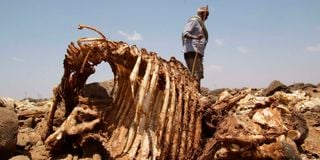Time state declared the ravaging drought a national emergency

Guyo Ibrae inspects carcasses of his livestock that died for lack of pasture sue to drought at Tigo village, Marsabit County, on February 10.
The number of hungry Kenyans has shot up from 4.2 million to six million with six million requiring humanitarian assistance, showing the impact of the drought on food security in 23 counties in arid and semi-arid lands (Asal).
The ravaging drought from the fifth consecutive season of poor rainfall has seen water sources dry up in the pastoralist areas. The worsening crisis requires an urgent scale-up of interventions from concerted efforts. Northern Kenya, particularly, is in dire need of food assistance with 40 per cent of the population in the emergency stage (IPC4).
Most permanent rivers have stopped flowing, signalling a possible famine if drought risk management measures are not urgently put in place to cushion drought-stricken populations. Athi, Thika and Chania rivers are already dry. As is the famous Mara River, which is fed by Mau Forest. And also the Malewa River, which flows from the Aberdares and drains into Lake Naivasha.
National disaster
That is why the President ought to formally declare the drought a national disaster and deploy every apparatus of government to prevent further loss of lives and livelihoods. It’s evident that people will die from starvation; you don’t have to wait for that to provide relief food. Donors and other non-state actors may not be willing to respond to the drought crisis until the government declares it a national disaster.
The drought has also exacerbated human-wildlife conflict as wild animals roam villages in search of food and water. It has also led to the loss of nearly 70 per cent of livestock for lack of pasture and water in the affected counties. The remaining ones might soon be wiped out by drought.
At least seven counties in the north face an emergency food situation and the Famine Early Warning Systems (Fews) Network has warned that pastoralist regions are on the verge of a critical phase. These are Turkana, Marsabit, Tana River, Isiolo, Wajir, Mandera and Garissa, with a combined population of 6.6 million mostly in dire need of food aid. Other counties that are at risk include West Pokot, Laikipia, Kajiado, Kilifi and Kwale.
Nutrition situation
The drought is so severe that there is an influx of pastoralists migrating to urban centres, as in Mandera, in search of food aid.
The government should distribute relief food, scale up cash transfers and provide supplementary feeding to children in the most affected areas. The nutrition situation is likely to worsen in the next three months as the drought persists, which could see thousands of children drop out of school due to hunger.
That calls for a supplementary school feeding programme to be put in place. The recent food rations given by county governments geared towards supporting the most vulnerable is not enough for a month.
That calls for national government support to avert a looming widespread humanitarian disaster, especially in the north, as thousands of lives are at risk from climate-related livestock losses due to the ongoing drought.
There is a need for a permanent solution to the cyclic drought as the affected populations cannot depend on relief food forever. One way would be to put in place strategies to stop reliance on rain-fed agriculture and instead invest in irrigation farming. Reliance on rain-fed agriculture and livestock off-take programmes have proved futile in the fight against drought and the resultant famine.
The government should conduct an emergency assessment in the affected counties in a bid to design practical and appropriate response strategies. It should also immediately supply relief food to the affected populations as a short-term intervention to ward off more loss of human life.
The number of citizens facing hunger and suffering the effects of drought has gradually increased over the years. Declaring drought a national disaster and even fundraising to support those in hunger-stricken areas is not a solution.
A paradigm shift in the manner in which past governments have addressed the effects of drought is overdue. We need a solution to this seemingly unending cycle.
Mr Adankhalif is a disaster risk management consultant. [email protected].





